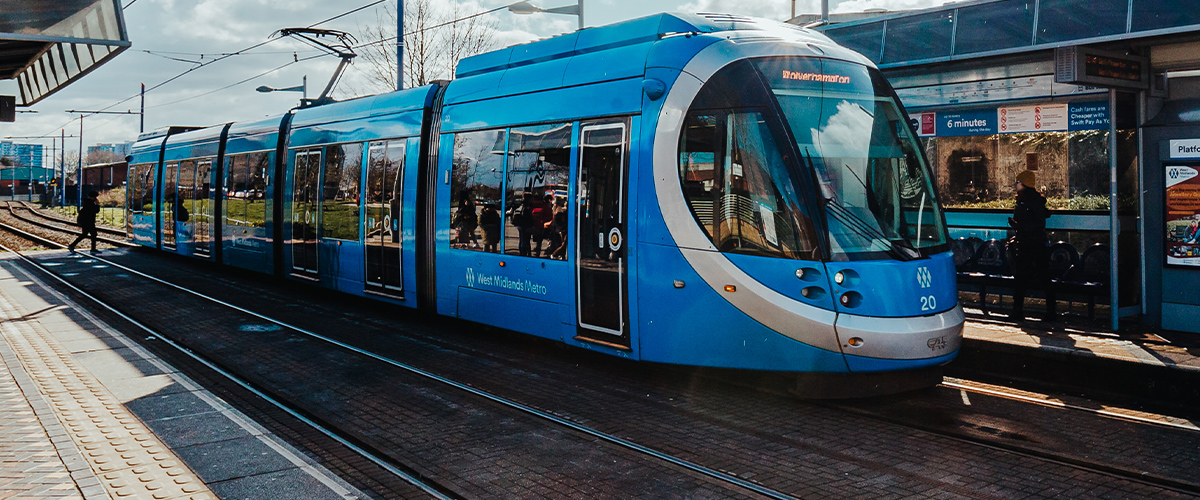West Midlands 5G (WM5G) has developed the UK’s very first 5G-connected tram as part of a regional transport trial in partnership with West Midlands Metro, Transport for West Midlands (TfWM), GoMedia and Icomera.
Trams collect a variety of valuable information, including CCTV footage and vehicle performance and maintenance data. Currently, this information is accessed and downloaded manually, outside the hours of operation.
With the UK’s first 5G-connected tram, 5G’s increased bandwidth allows for high-definition CCTV footage captured on the tram to be securely and remotely transferred to the Regional Traffic Control Centre while in operation.
This ability to transmit high-levels of data almost instantaneously unlocks incredible opportunities to further strengthen passenger safety and has now been proven by WM5G and its partners.
The on-board connectivity would also allow passengers to enjoy live travel updates and the ability to stream on-board entertainment, a feature that has become the gold-standard for public transportation.
It will also enable operators to more flexibly manage services to meet passenger demand and navigate challenges related to COVID-19, including managing social distancing and boosting public confidence as life returns to normal post-pandemic.
Being able to access real time information such as passenger numbers will help operators establish capacity, minimise crowding in stations and onboard services. It will also make journeys safer and better tailored to real-time passenger demand, meaning a more agile, cost effective service.
Andy Street, Mayor of the West Midlands, said: “Transport is an integral cornerstone to any region and the West Midlands is breaking new ground in using 5G to developing transport that is fit for the future. The development and improvement of our regional transport network also provides better connections to jobs and employment opportunities, helping local communities and businesses to grow and thrive.”
Matt Warman, Digital Infrastructure Minister at the Department for Digital, Culture, Media and Sport added: “The birthplace of the industrial revolution is now at the forefront of the digital revolution with 5G being used to improve efficiency and passenger safety on the West Midlands Metro.
“We have invested £200 million to explore how 5G can be the rocket fuel industries need to build back better and this is just one of a long list of projects to make the most of this ultrafast mobile technology.”
If deployed across the network, 5G-connected trams could also utilise on-board sensors to help engineers remotely identify issues in carriages and across infrastructure, predicting and responding to faults before they occur.
Chris Holmes, Programme Director of Transport at WM5G, said: “This project is a great demonstrator of how 5G can transform the way that public transport services are delivered. Our 5G-connected tram is a great showcase for what the future of connected transport could look like across both the West Midlands and beyond.”
Sophie Allison, Head of Business Transformation at West Midlands Metro, commented: “We’re proud to be working in partnership on this new initiative, it’s our shared ambition to utilise new technologies to improve services for passengers across the region. This collaboration has enabled us to use the advances in 5G technology to monitor the tram network in real-time.
“As well as unlocking the potential for a host of initiatives to enhance the customer experience, we now have the proven ability to transmit CCTV footage to our Operational Control Centre and the Regional Traffic Control Centre quickly, reliably and securely – helping to improve passenger safety. We are pleased to be pioneers on this project, which has helped to demonstrate the benefits of 5G.”
Seven further transport trials across the region are currently underway, with WM5G investing £2.4 million in seven UK-based consortiums to support the development of new products and services to transform transport.
The projects are scheduled to run until the end of 2021, trialling and testing further innovative services to improve areas such as road and rail operational efficiency, provide better-connected transport, or improve passenger experiences.
For more information, visit the WM5G website.



